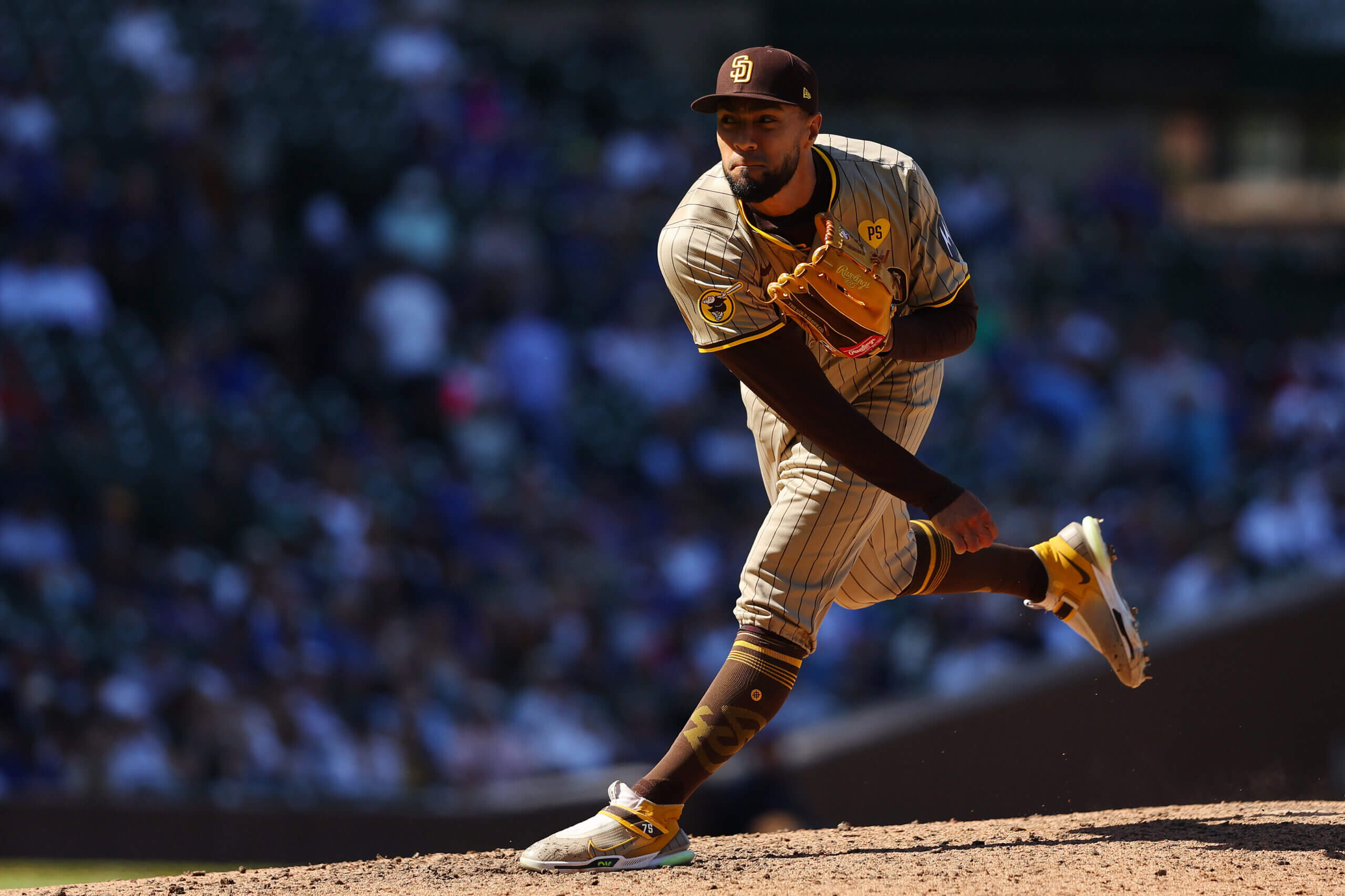Sports
Why Padres’ Robert Suarez spams fastballs — and why hitters still can’t hit them

SAN DIEGO – Kyle Higashioka has spent seven seasons crouching behind home plate for Aroldis Chapman, Gerrit Cole and other pitchers with rare arms and unusual speed, but in his first season with the Padres, the veteran catcher has marveled at what feels like a real anomaly .
Robert Suarez, San Diego’s soft-spoken, hard-throwing closer, spams high heat like no other pitcher in the majors. His combined fastball usage is up nearly 30 percentage points from last season. He has taken to his four-seater just over 80 percent of the time, which averages 97.5 miles per hour. He has mixed his sinker (averaging 97.9 mph) on nearly 11 percent of his pitches. And in a remarkable eight-game stretch last month, Suarez reached 79 straight fastballs.
“People don’t even do that in high school,” said Higashioka, who played prep ball against Cole more than a decade before the two Southern California natives became battery mates with the New York Yankees. “It’s pretty crazy.”
It would be even more surprising if the 33-year-old Suarez had limited success with such an approach. But the Venezuelan right-hander is neither stubborn nor unimaginative. Suarez has an ERA of 0.52 across sixteen appearances. In an otherwise shaky Padres bullpen, he is tied for the major league lead in games completed (16), saves (12) and saves of more than three outs (three). Opponents are hitting .250 (1-for-4) against his plus changeup and just .093 (4-for-43) against a four-seamer that justifies the heavy usage.
“It’s got the drive, the characteristics, and he’s pitching at the top of the zone,” Los Angeles Dodgers manager Dave Roberts said. “You know what’s coming, but a lot of the swings (batters) just can’t catch up. I don’t like it when he comes into the game.”
Why is a commonly seen fastball so unhittable?
“I’ve been helped a lot by (Padres pitching coach) Ruben Niebla in using all kinds of analytics on my pitches, especially spin rate,” Suarez said recently through team interpreter Pedro Gutiérrez. “It allowed me to execute a little bit more.”
On Saturday, hours after Suarez threw 11 four-seamers, two sinkers and nothing else in a perfect inning against the Dodgers, Niebla explained in more detail.
Suarez has acquired a practical understanding of spin efficiency, Niebla said, since San Diego dropped him from Japan’s top league after the 2021 season. While there is no proven way to significantly increase raw spin rate without the help of banned foreign substances, Suarez has increased the rate active spin – a Statcast metric that measures the spin that contributes to movement – on his quad from 93.7 percent in 2022 to 95.9 percent this season. Since the end of 2023, the field has gained almost an inch of average vertical movement, the “drive” Roberts called.
“If he starts working into the ball a little too much, his four-sieve starts running and we start to lose spin efficiency,” Niebla said. “If it cuts a little bit, we’re going to lose spin efficiency. At this point it seems like it’s clicking. Statistically he is behind the ball and really gets that pure backspin.
More than 90 percent of Robert Suarez’s pitches this season have been fastballs. (Tim Nwachukwu/Getty Images)
Calibrating Suarez’s delivery was crucial. Early in spring training, Niebla noticed that the pitcher was moving his lower half down the mound well, but also that his torso was “a little behind.” Suarez struggled in his first few appearances in the Cactus League, even as he and Niebla worked to address the root cause. It wasn’t until Suarez’s final spring appearance in Arizona that Niebla felt the reliever had fully synchronized his timing.
“Even when he went to Korea (for the season opener against the Dodgers) … I was still a little nervous, and then it was good,” Niebla said Saturday at Petco Park. “Then he came here. And then you just follow – I just follow. But right now I find it quite easy that I don’t even have to talk to him. It’s just like, “You’re in the rhythm.” I don’t even tell him he’s in the rhythm.”
Higashioka played six seasons with Chapman, who still holds the Guinness World Record for the fastest Major League pitch, a ball won by Tony Gwynn Jr. in 2010. was thrown at Petco Park. “He puts in quite a lot of effort,” Higashioka said. “You could see he was using all his strength to get everything behind him.” Suarez, meanwhile, has what approaches the textbook definition of ‘easy gas’.
“Sometimes,” said Padres starting catcher Luis Campusano, “it almost teleports into my glove.”
Those who have spent any time around Suarez point out otherwise.
“He has really good control,” Roberts said.
“When I caught the first bullpen, I was amazed at the command,” Higashioka said. “It was just almost precise. And for someone to roll 100 with an above-average command, I mean, that’s pretty special.
“There’s a combination of being able to hit 100, but also being able to hit 100 if this guy puts it to the top of the zone and then goes to the outside half of the zone, and all of a sudden there’s a two-seater that he can lock you in,” Niebla said. “It’s like, ‘Oh, s–, was that it or was that the other one?'”
During his run of 79 consecutive fastballs, Suarez threw 74 four-seamers and five sinkers. He allowed no runs, two singles and two walks. (The only run off Suarez this season came on March 28 when Michael Conforto made a change for a solo homer.) He recorded just five strikeouts, but he provided consistent weak contact and kept batters off balance with the speed of his delivery to vary.
Somewhere around the fortieth or fiftieth fastball in a row, some of Suarez’s teammates started talking to each other: something else was going on.
“I think we were all just kind of monitoring,” Higashioka said. “We noticed that he didn’t really throw anything different, but he still dominated. It was pretty cool.”
“I know his fastball usage is high, but it has been his best weapon. It is his best weapon,” Campusano, Suarez’s main battery mate, said April 22 before a game at Coors Field. “So just mixing it all together all the time really makes it much more effective. I feel very confident in just using it until someone can prove they will put a good spin on it.
‘You know a hundred are coming. You just don’t know where it’s going to go.”
Robert Suárez 160 km/h ⛽️⛽️ pic.twitter.com/ZMSQtDHInk
— Rob Friedman (@PitchingNinja) May 7, 2024
Of course, a careful competitor never reveals too much. Just hours after Campusano spoke, the catcher called for a 1-2 changeup instead of what would have been Suarez’s 80th straight fastball. Sean Bouchard made a mistake. Then, on the next pitch, the Colorado Rockies outfielder doubled.
It was the only extra-base hit Suarez had surrendered with his fastball this season. Now, three weeks later, that is still the case. And Suarez has only increased his use of that pitch. So far in May, he’s throwing the quads almost 90 percent of the time. Hitters this month are 0-for-14 against it.
“It’s like this is my strength,” said Niebla, who insists Suarez continues to work on his changeup and cutter/slider between games, a throw he has yet to throw in a game this year. “As a reliever you have to use it.”
Since the era of pitch tracking began in 2008, only a dozen pitchers have thrown a four-sieve, a sinker or a cutter on at least 90 percent of their pitches (minimum 500 total pitches). Mariano Rivera, widely recognized as the greatest closer of all time, leads the way with 98.5 percent; his famous cutter included 87.6 percent of his throws during that period.
Over the past sixteen seasons, no one has thrown a four-sieve or sinker more than 86.7 percent of the time. In 2024, Suarez (68.3 percent over his career in the big league) is at 91.3 percent. The only pitcher throwing non-cutter fastballs more often this season is former Padres reliever Tim Hill, and the left-hander’s four-seamer average is 8 mph slower than Suarez, who has recorded 13 pitches of at least 100 mph.
There may come a time when opponent adjustments or other factors push Suarez to dial back the extreme fastball dependence. For now, who knows when his next off-speed pitch will come: One of baseball’s more automatic closers entered Sunday having thrown 32 consecutive fastballs.
(Top photo of Robert Suarez: Michael Reaves / Getty Images)













